GUERNICA, 80 AÑOS
- The Trendy Man
- 12 may 2017
- 4 Min. de lectura
Actualizado: 22 nov 2019

Mira que habré visto el cuadro de El Guernica cientos de veces en el Reina Sofia y siempre que voy me estremezco y descubro cosas nuevas en el lienzo. Esta vez la ocasión era especial; se cumplen 80 años desde que Picasso lo pintase y el Museo nos ha sorprendido con una impresionante exposición sobre la obra del artista antes y el después del Guernica.
Yo te recomiendo que empieces el recorrido desde el principio, que no te saltes nada; de está forma comprenderás por todas las etapas que atravesó el pintor antes de llegar a crear el Guernica. Son las claves de la creación de esta magnífica obra.
Siento no poder ofreceros mis propias fotografías de la exposición. Está prohibido tomar instantáneas así que me ha tenido que conformar con las fotos que facilita el propio Museo.
I had seen the painting of El Guernica maybe one hundred times at the Reina Sofia and whenever I go I shudder and discover new things on it. But this time is different, a new exhibition marking the 80th anniversary of the creation of Picasso’s masterpiece is unveiled in Spain last 5 April. The exhibition, ‘Pity and Terror in Picasso’, opened at the Museo Reina Sofía. The great mural is at the centre of the show. It looks again at Picasso’s depiction of modern warfare – war from the air, death from a distance, aimed at the destruction of whole populations – and the special kinds of agony, bewilderment, and terror such warfare brings with it.
I am sorry that I can not offer my own photographs of the exhibition. It is forbidden to take snapshots so I had to use the photos provided by the Museum itself.



Todo se remonta a 1937, cuando el gobierno republicano de la época encargó a Pablo Picasso, por entonces director del Museo del Prado, una obra de denuncia social que terminó por convertirse en uno de los cuadros más icónicos del artista malagueño. Debía reflejar el terror de la Guerra Civil española y se expondría en el Pabellón Español de la Exposición Internacional de París de ese mismo año.
Picasso, que pasaba por una crisis personal y artística, eligió ilustrar el bombardeo que vivió la ciudad vasca de Guernica el 26 de abril de ese mismo año.
Yo creo que quiso crear una especie de "antimonumento", una respuesta ante el mundo que se abría paso ante él pero que aún le resultaba ajeno. Surgían los fascismos, los extremismos, nuevas formas de comunicación, pero, sobre todo, la muerte amenazaba de forma "masiva". El lienzo, de 3,50 x 8 metros, conmocionó. El desgarro de una madre, el cuerpo inerte de un niño, una habitación que se desquebraja, la violencia explícita…Sus interminables interpretaciones comenzaron a escribir un capítulo de la historia del arte que cumple 80 años.
Regarded by many as one of history’s most powerful anti-war masterpieces, the mural-sized oil painting was created in response to the 1937 bombing of Guernica during the Spanish Civil War. Commissioned by the Spanish government for display at the 1937 World’s Fair in Paris, the image illustrates the suffering of people and animals in a palette of grey, black, and white.
The Reina Sofia exhibition promises to be extraordinary. “Unlike other retrospectives on the art of the Málaga-born genius, this show places the emphasis on the evolution of Picasso’s pictorial universe, with “Guernica” at its epicenter, from the late 1920s until the mid-1940s, a period when the artist brought about a radical change in his oeuvre,” a museum spokesperson says.
Through key works from that period, it will be possible to analyze the transformation undergone in Picasso’s art from the initial optimism of Cubism to his search in the 1930s, a period of great political tumult, for a new image of the world lying between beauty and monstrosity








El Guernica es capaz de representar lo mejor y lo peor del siglo XX, de reflejar terror y compasión al mismo tiempo. No sé para vosotros pero para mí el cuadro tiene una belleza y una monstruosidad de las que no te puedes liberar fácilmente.
No os perdáis los dibujos de Picasso previos al Guernica; observareis una serie de magníficos estudios previos de la mujer y el uso del lápiz y del color para trabajar el drama de los inocentes. El pintor transforma los pechos de las mujeres en armas, han mutado debido al terror.
The show begins with still lifes and interiors of 1924-25, charting Picasso’s treatment of monstrosity and violence in the later 1920s and 1930s, then taking the story beyond “Guernica” to portraits and interiors done as World War II began, and ending with the artist’s attempts in the 1950s to return to “history painting” in works like “Massacre in Korea” and the UNESCO mural, “Fall of Icarus.”
Don’t miss this incredible show.


Es difícil no ver el Guernica y no emocionarse. Es la obra del siglo XX que más interpretaciones ha suscitado, cada uno ve algo diferente en el cuadro y nunca te de deja indiferente.
"Piedad y terror en Picasso: el camino a Guernica" estará abierta al público hasta el 4 de septiembre. No os la perdáis.
It is difficult not to see the Guernica and not get excited. It is the work of the twentieth century that more interpretations have aroused, each one sees something different in the picture and never leaves you indifferent.
"Pity and terror in Picasso: the road to Guernica" will be open to the public until September 4. Do not miss it.

LA ROPA QUE LLEVO ES DE COS
ALL I AM WEARIN IS COS
Comments